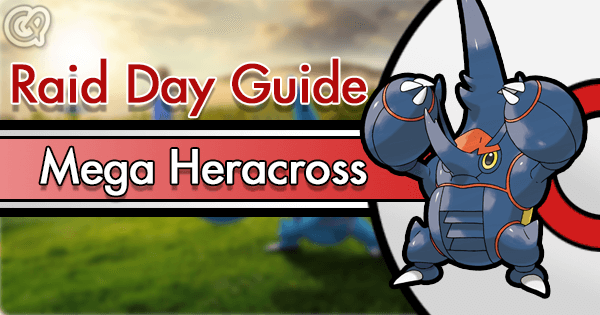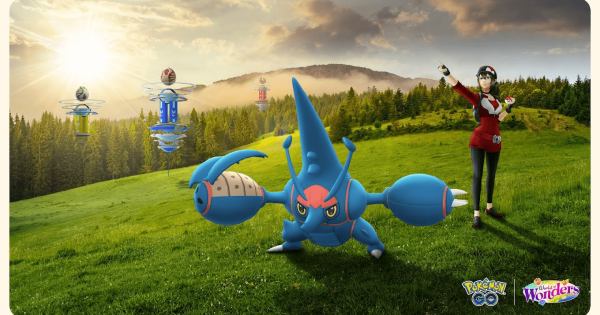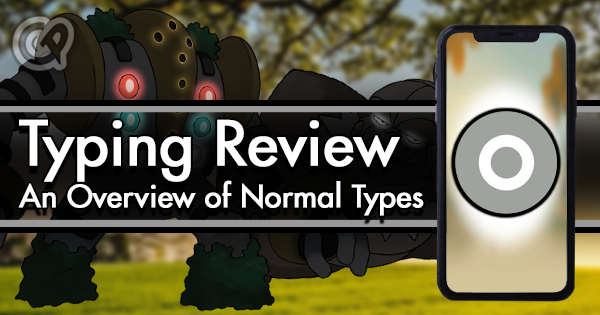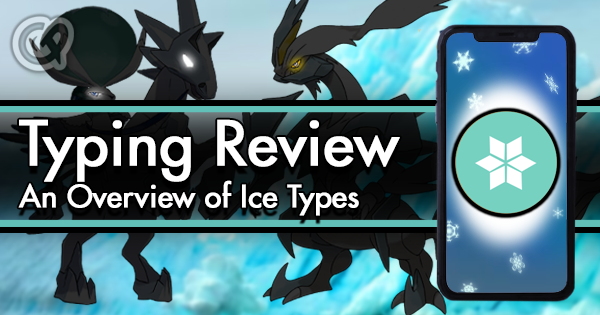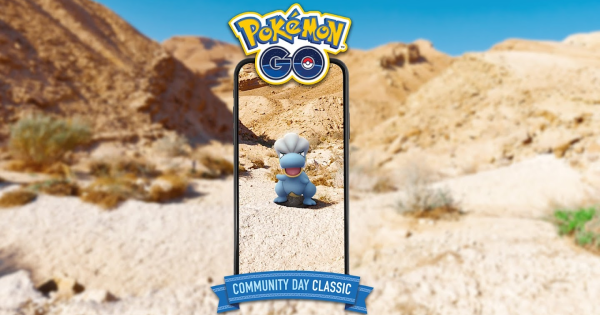Introduction
This article is the last part of a 3-part series employing a method of graphical representation that graphically compares attackers in terms of power and time. Whereas the first 2 articles in this series focus on the best attackers into common defenders, this article compares the defenders relative to each other.
Some readers mused about what would happen if we were to take all of the plots presented over the first 2 articles and superimpose them on each other. Such a plot would yield a representation on how defenders perform, but it would be a huge unreadable mess. Thankfully, there are ways to trim the data to yield a useful graphic.
This article aims to answer 3 questions:
- How do the "big 7" defenders compare to each other?
- How do lower CP but theoretically good defenders perform?
- What is the impact of having a good moveset for a "big 7" defender?
What is a Pareto Frontier?
Wikipedia says:
Pareto efficiency or Pareto optimality is a state of allocation of resources from which it is impossible to reallocate so as to make any one individual or preference criterion better off without making at least one individual or preference criterion worse off.
The Pareto frontier is the set of all Pareto efficient allocations.
In our case, the 2 criteria that we are concerned about are power and time. Essentially, the Pareto frontier for any given defender is comprised of their worst matchups in terms of power, time, or some combination of both.
Take, for example, Snorlax's matchup plot:
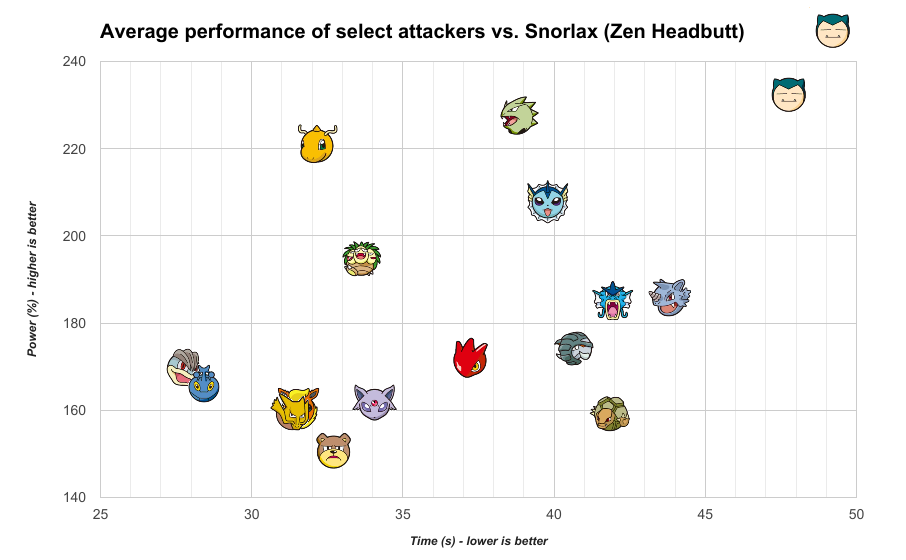
The Pareto frontier in this case contains Machamp, Dragonite, Tyranitar, and Snorlax, because none of them are strictly worse than another.
Conversely, Heracross, and by extension, everyone else, is not part of the Pareto frontier (i.e., it is not Pareto-efficient), because it is strictly worse than Machamp in terms of both power and time.
The Pareto frontier is useful when comparing defenders because against a well-informed player, a defender is only as good as its worst matchups.
A quick disclaimer: In many cases, Blissey and/or Snorlax are Pareto-efficient attackers. I chose to exclude them because they tend to warp the axes or make the graph less readable.
The "Big 7" at Their Best
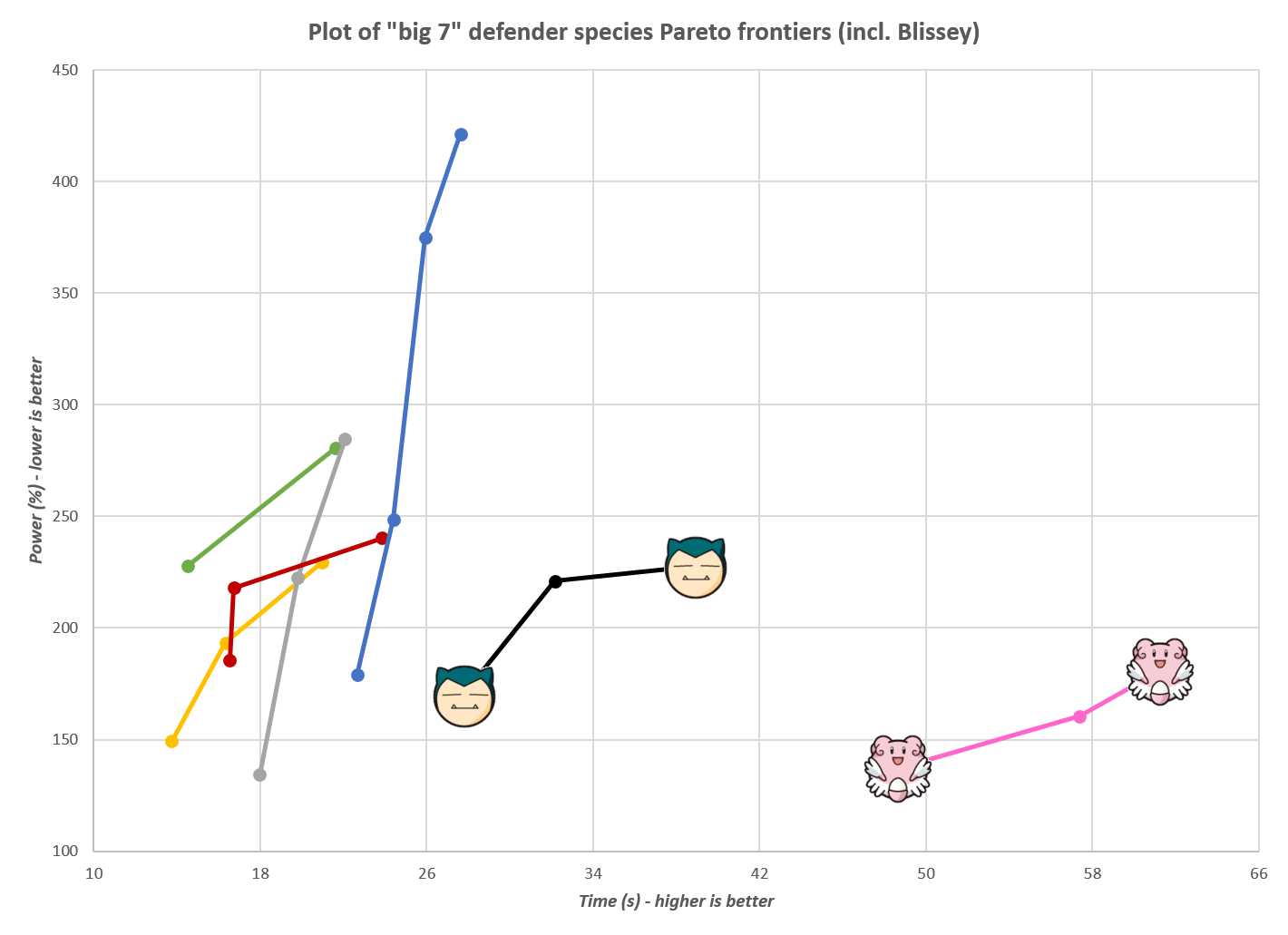
When we say that Blissey is approximately 2x as good as Snorlax and Snorlax is approximately 1.5x as good as any other Pokemon, we really mean it, and it's very obvious in this representation. The rest of the "big 7" species are positioned fairly close to each other on the left hand side of the graph.
Keep in mind that since we are comparing defenders, it is better for a species to be in the bottom right corner of the plot.
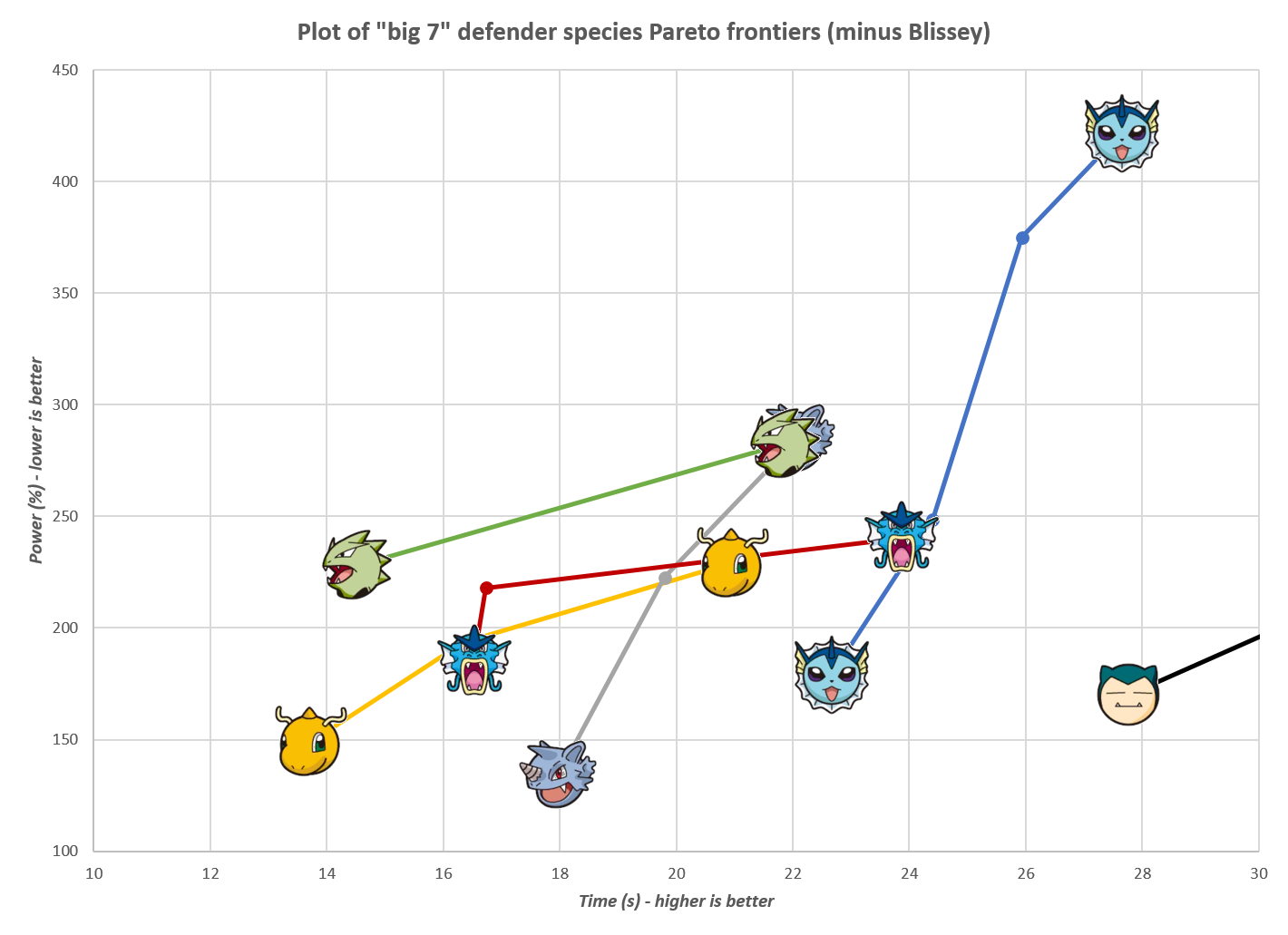
If we exclude Blissey and Snorlax to prevent them from warping the time axis, we can see that the tier 2.5 defenders all perform roughly the same. Tyranitar is clearly the worst, but Dragonite, Rhydon, and Gyarados all have minor strengths relative to each other. Vaporeon prolongs battles, but not nearly to the degree of Snorlax, and it tends to be wimpier because of Water Gun being a poor move on defense.
Outside the "Big 7"
One frequent complaint about the gym system expressed by the player base is how the CP ranking system crowds out theoretically "better" defenders than much of the "big 7." After all, 4 of those species have double weaknesses and inflated CP, so they must be awful, right?
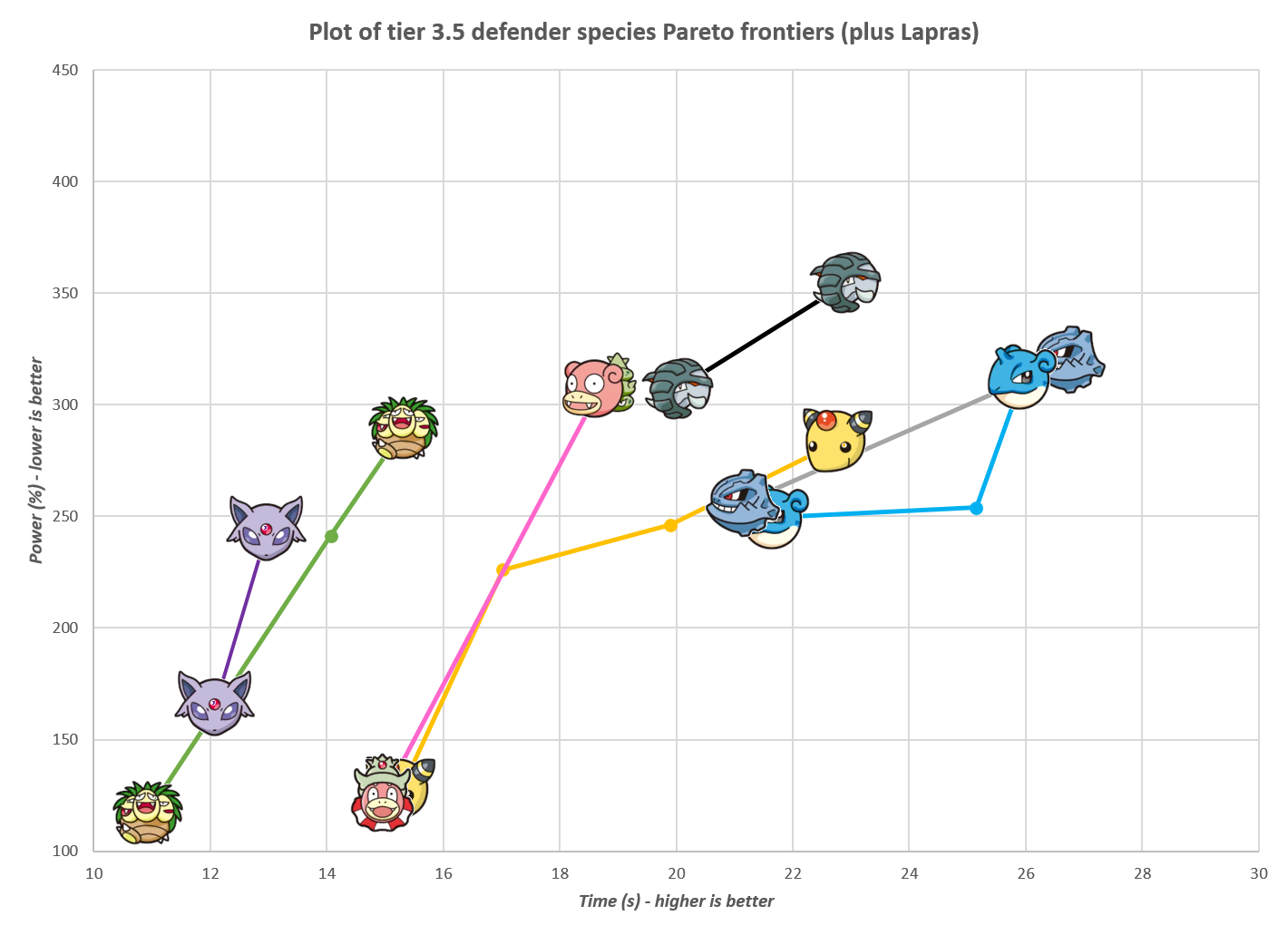
This graph contains all of the tier 3.5 defenders plus Lapras, plotted on the same axes as the previous graph. While Lapras and Steelix clearly lead the pack, overall, the differences between tier 3.5 defenders and the non-Blissey, non-Snorlax "big 7" are actually quite small.
Still, if all of these species had competitive CP or if CP wasn't a factor in gym placement, then one could imagine a more diverse gym metagame that contained 15+ commonly-seen defender species instead of just 7. (Niantic pls)
The "big 7" at Their Worst
Although at GamePress we discuss at length about ideal or near-ideal movesets, in the real world, most players just stick their highest CP "big 7" Pokemon in a gym. As a result, it is quite common to fight defenders with bad defensive movesets, and they should not be ignored. Many GamePress readers have also wondered what tier their Pokemon would fall in with a non-ideal defensive moveset.
When generating the individual matchup plots in the previous articles (and by extension, the defender graphs), I averaged only the defender species's best defensive movesets, typically determined by quick move.
So in the following graph, I averaged only the defender species's worst defensive movesets, also determined by quick move.
- Tyranitar: all Bite movesets
- Dragonite: all Steel Wing movesets (Dragon Breath exists but is legacy, so I didn't factor those sets)
- Snorlax: all Lick movesets
- Rhydon: all Rock Smash movesets
- Gyarados: all Bite movesets (Dragon Breath exists but is legacy, also is very similar to Bite)
- Vaporeon: same movesets as previous
The results were plotted on the same axes as the previous graphs to allow for direct visual comparison.
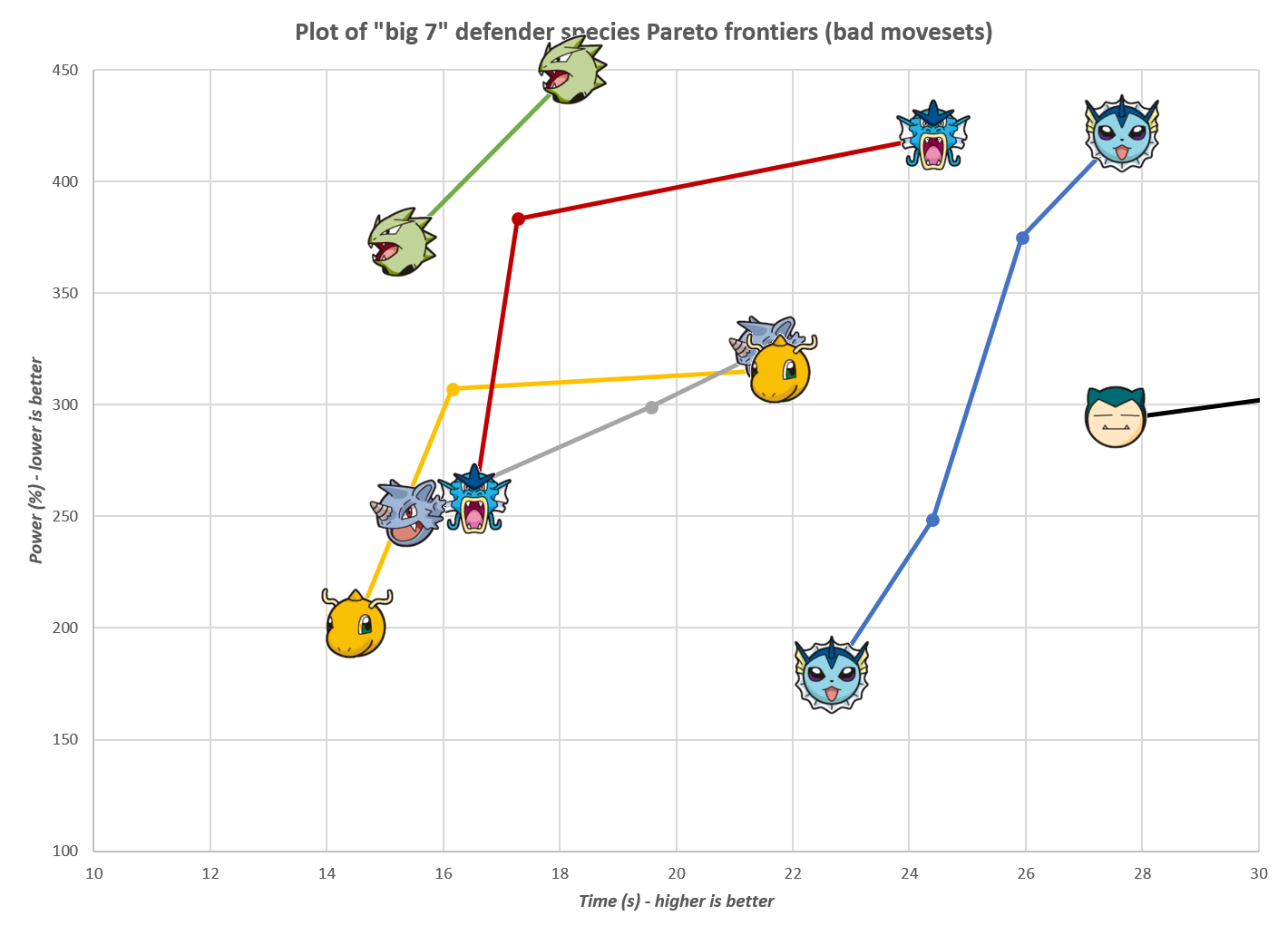
Having a bad moveset substantially increases the attackers' power ratings, but obviously doesn't have much of an impact on time. Dragonite and Rhydon aren't too much hampered by having Steel Wing and Rock Smash, respectively - they compare similarly to the tier 3.5 defenders. Tyranitar and Gyarados, on the other hand, suffer greatly from having Bite.
A Quick Note on Dodging
Please keep in mind that all of these graphs were generated using the dodge specials PRO attacking strategy on Pokebattler, in which the attacker only dodges the defender's charge moves and uses its own charge moves at the earliest possible opportunity. This strategy negatively impacts the performance of some defenders more than others.
Pokemon with weak quick moves, such as Vaporeon, are substantially hurt by this strategy, because most of their damage output comes from their specials. Conversely, this strategy helps Pokemon with strong quick moves, such as Espeon, Exeggutor, and Ampharos. In a real-world context, most players will dodge moves such as Confusion and Volt Switch, but not moves such as Water Gun or Bite.
However, it's worth pointing out that by forcing the attacker to dodge quick moves, the attacker has more opportunities to miss a dodge and may be more cautious about spamming attacks, thus prolonging battles.
Afterword
Whether a defender has a good moveset or a bad moveset is not going to deter another player from attacking a gym, nor will placing a Slowbro instead of a Gyarados or something similar. But that's not to say that defender moveset has no value at all - a good moveset may cost the attacker more healing items, which can make a difference in areas with low Pokestop density. In gyms fortified by a handful of Blissey, good defender movesets may be the difference between a permitting a full clear and forcing a premature exit, thereby costing attackers time.
Ultimately, in the current gym climate there are few true deterrents. A gym loaded with Blissey and Snorlax can stave off the faint of heart, but the most effective deterrents are not Pokemon at all: good location and promptness in reclaiming a taken gym.



